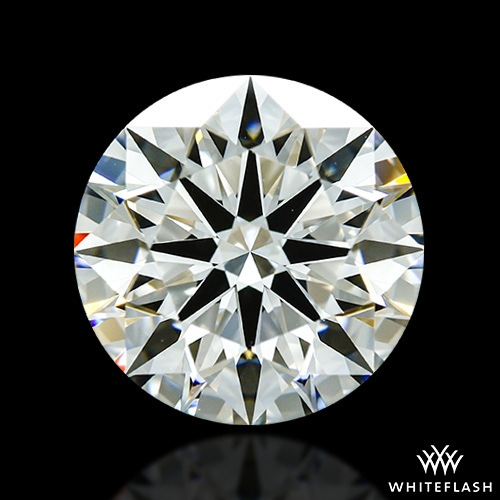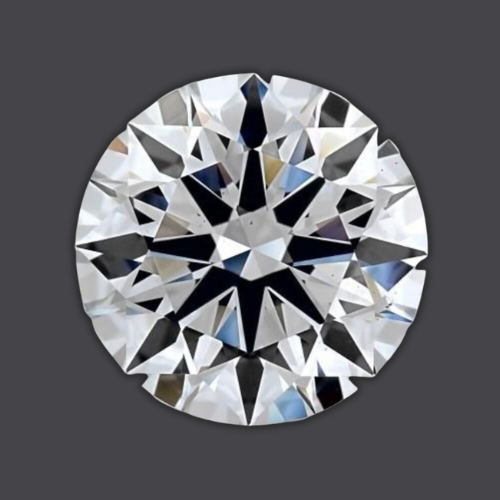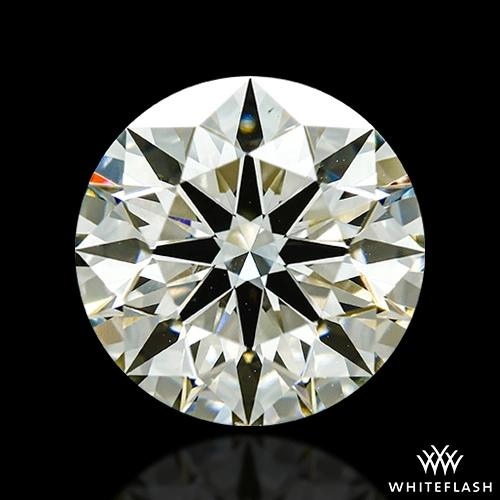A 1.5-carat stone is a fabulous choice if you want to go a bit above the crowd. The average diamond engagement ring carat weight in the US is about 1ct, so a 1.5ct makes a statement. Getting a ring that is larger and flashier can make a big impression! Choosing the perfect 1.5-carat diamond ring requires careful consideration of aspects, including cost, cut quality, size, clarity, and color. At PriceScope, we aim to guide you on this exciting journey, breaking down the complexities of selecting the ideal 1.5-carat diamond that aligns with your style, budget, and expectations.
When you are in the midst of a diamond shopping adventure, you want to give yourself every advantage you can.
Understanding Costs
Costs for 1.5 -carat diamonds vary based on factors such as cut quality, clarity, color, and shape. Understanding the 4 Cs of diamond quality will help you make informed purchasing decisions.
A gorgeous, high-quality 1.5-carat diamond ring can cost between $7,500 and $12,000. Opting for the highest quality can reach up to $33,000 while shifting the quality slightly can result in a price range of $4,500 to $6,200.
The cost of a 1.5-carat diamond depends on factors like cut quality, clarity, color, shape, and where you make the purchase. Generally, the best value for money falls within the $8,000 to $12,000 range. Diamonds below $8,000 may have noticeable imperfections or poor color. Diamonds above $12,000 offer higher quality, but the difference from a sub-$12,000 diamond may not be noticeable without magnification and specific lighting conditions.
1.5-Carat Diamonds at PriceScope
Staying updated with the current market prices is crucial when investing in diamonds. PriceScope's latest diamond prices chart provides real-time data on 1.5-carat diamonds, helping you make a wise investment decision. Stay informed and get the best value for your money with PriceScope.
Cut Quality for 1.5-Carat Diamonds
Diamond cut quality significantly impacts the price and beauty of a 1.5-carat stone. A superior cut enhances its value and light performance, maximizing sparkle, brilliance, and fire. Opting for an ideally or excellently cut diamond is advisable for the best results.
1.5-Carat Diamond Clarity
For a 1.5-carat diamond, a recommended minimum clarity grade is VS2 to ensure that inclusions and blemishes are not visible without magnification. However, assessing the diamond’s clarity or seeking expert guidance is wise. Getting a diamond with a reputable certification will help ensure the diamond’s clarity is to the standards you seek.
1.5-Carat Diamond Color
A diamond’s color is an important aspect in both price and appearance. For a 1.5-carat diamond, we suggest choosing a diamond in the H-J range. These near-colorless diamonds appear colorless to the naked eye but come with a lower price tag than the higher D-F range. A diamond’s color is an important aspect in both price and appearance. For a 1.5-carat diamond, we suggest choosing a diamond in the H-J range. These near-colorless diamonds appear colorless to the naked eye but come with a lower price tag than the higher D-F range. While cut quality has more impact on visual appeal, color is still significant, often based on personal preference. Some buyers may prefer a warmer hue and opt for a lower color grade to achieve it.
Ready to embark on your diamond-buying journey? The elite brands offered by our vetted vendors like Whiteflash A CUT ABOVE®, Astor by Blue Nile™, and JamesAllen.com True Hearts™ are collections of diamonds with superior cut quality.
Comparing 1.5-Carat Diamond Rings with 1-Carat and 2-Carat Varieties
The carat weight of a diamond determines its size and value, but it’s important to note that carat weight doesn’t have a linear relationship with size or appearance. A 1.5-carat diamond won’t be 1.5 times larger than a 1-carat diamond or half the size of a 3-carat diamond. The size difference is influenced by how carat weight is distributed throughout the stone, including its depth.
In terms of price, diamonds don’t increase in cost linearly with carat weight, but rather exponentially. Larger diamonds are rarer, contributing to their higher price. A 1.5-carat diamond won’t simply be one and a half times the price of a 1-carat diamond; it’s likely to be more expensive. Similarly, a 2-carat diamond will significantly exceed the price of a 1.5-carat diamond due to rarity.
However, carat weight is not the sole consideration when buying a diamond. The 4Cs—Carat, Cut, Clarity, and Color—all contribute to a diamond’s beauty and value. A flawless 1-carat diamond with exceptional cut, clarity, and color can sometimes be more valuable and visually stunning than a 1.5-carat diamond of lower quality.
1.5-Carat Diamond Sizes
When assessing a diamond, it’s important to understand that your eyes perceive its mass, not its weight. Since diamonds are typically viewed from the top, the measurements of the diamond’s face are crucial. Diamonds are measured based on their length, width, and depth. The diameter is the primary length measurement for round diamonds, though it is measured twice to ensure perfect roundness.
Its carat weight does not solely determine the size of a diamond. The table surface area, depth, and other shape features are not influenced by carat weight. These factors depend on the diamond’s shape and cut, which contribute to the diamond’s perceived size.
Regarding visual appeal, a 1.5-carat diamond strikes a balance for many buyers. It is noticeably larger than a 1-carat diamond, making it more striking and noticeable, but not as extravagant or costly as a 2-carat diamond. This makes 1.5-carat diamond rings an excellent choice for those seeking a blend of size, affordability, and visual impact.
1.5-Carat Diamond Costs by Shape
The shape of a diamond refers to its physical form, and there are many different shapes to choose from. While round cut diamonds are the most popular, many other shapes, known as ‘fancy cuts’, are equally stunning and might better suit your personal style or the style of the wearer.
Round Cut: The round cut diamond is the most popular diamond shape, representing approximately 75% of all diamonds sold. It is also generally the most expensive due to its demand and the fact that more rough diamond is lost in the cutting process. Shop Round Cut Natural & Lab Diamonds at Whiteflash.
Princess Cut: This is the second most popular shape. The princess cut is traditionally a square shape with sharp, pointed corners. It is less expensive than the round cut because less rough diamond is wasted during the cutting process. Shop Princess Cut Diamonds at PriceScope
Oval Cut: The elongated shape of the oval cut can create the illusion of greater size. The slender shape can also make the finger of the wearer appear longer and slimmer. Shop Oval Cut Diamonds at PriceScope
Pear Cut: Also known as the teardrop shape, the pear cut is both unique and beautiful. It can be worn with the pointed end towards or away from the hand, and the length of the shape can make the fingers appear longer. Shop Pear Cut Diamonds at PriceScope
Cushion Cut: The cushion cut has gained popularity over the past decade. It has a square or rectangular shape with rounded corners, resembling a pillow or ‘cushion,’ hence the name. Shop Cushion Cut Diamonds at PriceScope
Emerald Cut: This shape is more about the clarity of the diamond, as its large, open table (the flat facet on the diamond’s surface) can highlight any inclusions or blemishes. The elongated shape and step cuts of its facets create a sophisticated, glamorous appearance. Shop Emerald Cut Diamonds at PriceScope
Asscher Cut: The Asscher cut is a stepped square cut, often called the “square emerald cut.” It has cropped corners and showcases the clarity of the diamond. Shop Asscher Cut Diamonds at PriceScope
Marquise Cut: This football-shaped cut can maximize carat weight, giving the appearance of a much larger diamond. The long, narrow shape can also make fingers look longer and more slender. Shop Marquise Cut Diamonds at PriceScope
Radiant Cut: The radiant cut combines the emerald cut’s stylish lines with the round cut’s brilliance. It’s a versatile cut that can be used in various ring styles. Shop Radiant Cut Diamonds at PriceScope
Heart Cut: A less common shape, the heart cut diamond is a symbol of love. The complexity of the shape requires a high degree of skill to ensure the proper symmetry and proportion, so it’s essential to find a reputable jeweler. Shop Heart Cut Diamonds at James Allen, and Blue Nile
The shape of the diamond can significantly influence the aesthetic of your ring. Some shapes can make the diamond appear larger, while others highlight the diamond’s clarity. Ultimately, the best shape to choose is the one that most appeals to you or your loved one. Check out the popular diamond shapes on the market in real-time. **Updated monthly at PriceScope

Reasons Why It’s Important To Purchase A Certified 1.5-Carat Diamond
- Authenticity: Certification from a reputable lab guarantees that the diamond is real and not a synthetic or a look-alike stone such as cubic zirconia or moissanite.
- Quality Verification: A certified diamond comes with a report detailing its specifications, including the 4Cs—Carat, Cut, Color, and Clarity. This document verifies the diamond’s quality and provides transparency about its characteristics, enabling you to understand exactly what you’re buying.
- Value for Money: Certification helps to ensure that you’re paying a fair price for the diamond. By knowing the precise quality and characteristics of the diamond, you can compare prices across different sellers and make a more informed decision.
- Resale Value: If you ever decide to sell or trade-in your diamond in the future, the certification will play a crucial role. Certified diamonds typically have higher resale values because the next buyer or jeweler can be confident about the diamond’s quality.
- Insurance: In case of loss or damage, insurance companies usually require detailed information about the diamond, which is readily available in the certificate. This documentation helps establish the diamond’s value and replace it accurately.
Certification doesn’t just provide assurance—it is a critical tool for comparing diamonds, understanding their worth, and ensuring your investment is sound. It’s important to ensure the diamond is certified by a reputable institution such as the Gemological Institute of America (GIA), the American Gem Society (AGS), or the International Gemological Institute (IGI). These organizations are known for their rigorous standards and unbiased evaluations.
After exploring our comprehensive guide on 1.5-carat diamonds, why not browse the high-quality 1.5-carat diamonds offered by our vetted vendors? To simplify your search click through to the 1.5-carat diamonds offered by Whiteflash, Continental Diamond, Adiamor, Blue Nile and James Allen.
Final Thoughts
To get the most value from a 1.5-carat diamond, prioritize its cut, color, clarity, and shape. Choose a diamond with a reputable certificate to ensure lasting performance and quality. Trustworthy vendors, such as the vetted vendors on PriceScope, are always recommended. Keep in mind that emotions often affect diamond prices and can be subjective.
Following expert advice and thorough research will help you find a high-quality, exquisite diamond that will continue to impress for generations to come.
If you want personalized help buying a diamond ring in the 1.5ct range, feel free to utilize our diamond concierge service , and we’ll help you choose the best options for your tastes and budget.



